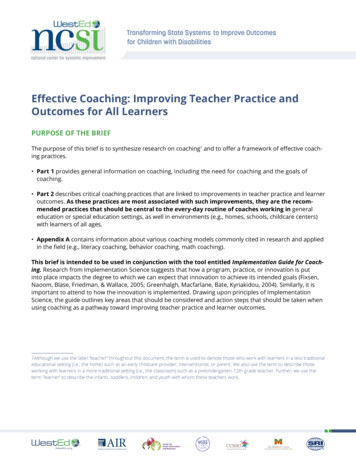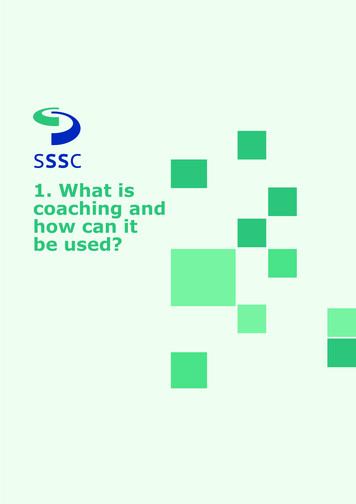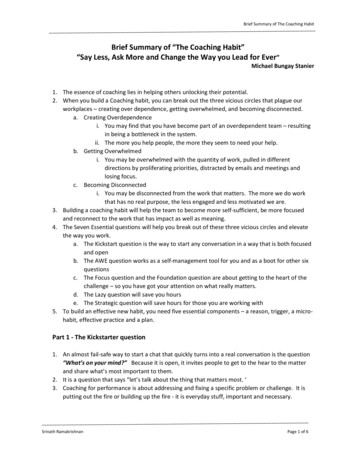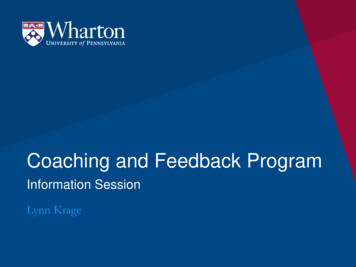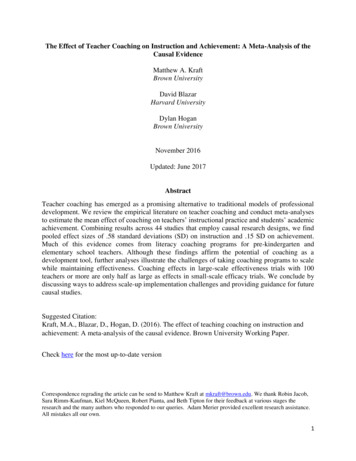
Transcription
The Effect of Teacher Coaching on Instruction and Achievement: A Meta-Analysis of theCausal EvidenceMatthew A. KraftBrown UniversityDavid BlazarHarvard UniversityDylan HoganBrown UniversityNovember 2016Updated: June 2017AbstractTeacher coaching has emerged as a promising alternative to traditional models of professionaldevelopment. We review the empirical literature on teacher coaching and conduct meta-analysesto estimate the mean effect of coaching on teachers’ instructional practice and students’ academicachievement. Combining results across 44 studies that employ causal research designs, we findpooled effect sizes of .58 standard deviations (SD) on instruction and .15 SD on achievement.Much of this evidence comes from literacy coaching programs for pre-kindergarten andelementary school teachers. Although these findings affirm the potential of coaching as adevelopment tool, further analyses illustrate the challenges of taking coaching programs to scalewhile maintaining effectiveness. Coaching effects in large-scale effectiveness trials with 100teachers or more are only half as large as effects in small-scale efficacy trials. We conclude bydiscussing ways to address scale-up implementation challenges and providing guidance for futurecausal studies.Suggested Citation:Kraft, M.A., Blazar, D., Hogan, D. (2016). The effect of teaching coaching on instruction andachievement: A meta-analysis of the causal evidence. Brown University Working Paper.Check here for the most up-to-date versionCorrespondence regrading the article can be send to Matthew Kraft at mkraft@brown.edu. We thank Robin Jacob,Sara Rimm-Kaufman, Kiel McQueen, Robert Pianta, and Beth Tipton for their feedback at various stages theresearch and the many authors who responded to our queries. Adam Merier provided excellent research assistance.All mistakes all our own.1
The Effect of Teacher Coaching on Instruction and Achievement: A Meta-Analysis of theCausal EvidenceProviding high-quality professional development to employees is among the mostimportant and longstanding challenges faced by organizations. Investments in on-the-job trainingoffer large potential returns to workforce productivity. However, high-quality programs haveproven difficult to develop, scale, and sustain. These challenges are particularly acute in thepublic education sector given the size of the teacher labor market and the dynamic nature of thejob. Every day, over 3.5 million teachers in the United States (U.S.) face unique challengeseducating students who enter the classroom with a wide range of knowledge, skills, and needs.Across the U.S., school systems spend tens of billions of dollars annually on professionaldevelopment (PD) to help teachers meet these daily challenges with limited results to show forthese investments.1 Impact evaluations find that PD programs more often than not fail to producesystematic improvements in instructional practice or student achievement, especially whenimplemented at-scale (Jacob & Lefgren, 2004; Garet et al., 2008; Garet et al., 2011; Garet et al.,2016; Glazerman et al., 2010; Harris & Sass, 2011; Randel et al., 2011). These findings areparticularly troubling given the wide variation in effectiveness across teachers and the lastingimpact teachers have on long-term student outcomes in the labor market and beyond (Chetty,Friedman, & Rockoff, 2014; Jackson, 2016). Both of these findings make improving the skills ofthe teacher workforce a societal and economic imperative (Hanushek, 2011). The need forfurther training has only grown in recent years as professional expectations for teachers continue1Arriving at an exact estimate of total expenditures on PD is complicated by the fact that federal requirements havedistricts report expenditures on PD as part of an “Instructional staff services” category which also includesexpenditures for curriculum development, libraries, and media and computer centers. Most studies find that districtsallocate 3% to 5% of their total budget to support teacher development (Odden, Archibald, Fermanich, & Gallagher,2002; Miles, Odden, Fermanich, Archibald, & Gallagher, 2004). Given that total expenditures for U.S. K-12 publicschools were 620 billion in 2012-13, even a conservative estimate puts this number in the tens of billions (Jacob &McGovern, 2015).2
to rise and states adopt new “college- and career-ready” standards that require teachers tointegrate higher-order thinking and social-emotional learning into the curriculum.The failure of traditional PD programing to improve instruction and achievement hasgenerated calls for research to identify specific conditions under which PD programs mightproduce more favorable outcomes (Desimone, 2009; Wayne, Yoon, Zhu, Cronen, & Garet,2008). These efforts have led to a growing consensus that effective PD programs share several“critical features” including job-embedded practice, intense and sustained durations, a focus ondiscrete skill sets, and active-learning (Darling-Hammond, Wei, Andree, Richardson, &Orphanos, 2009 ; Desimone, 2009; Desimone & Garet, 2015; Garet, Porter, Desimone, Birman,& Yoon, 2001; Hill, 2007). A recent meta-analysis found that math- or science-oriented PDprograms with many of these features were associated with improvements in both instructionalpractices and academic achievement (Scher & O’Reilly, 2009). However, this review identifiedonly one randomized control trial, and many of the quasi-experiments it included “hadsignificant methodological weaknesses” (p.223). Kennedy’s (2016) findings from a graphicalanalysis of popular design features in PD programs were more mixed: a focus on contentknowledge, collective participation, or intensity did not appear to be associated with programeffectiveness. We extend this work by reviewing the causal evidence on one specific PD modelthat is centered on several of these “critical features” and that has gained increasing attention inrecent years: teacher coaching.Teacher coaching has a deep history in educational practice. Pioneering work by Joyceand Showers in the 1980’s helped to build the theory and practice of teacher coaching as well assome of the first empirical evidence of its promise (Joyce & Showers, 1982; Showers, 1984,1985). They conceptualized coaching as an essential feature of PD training that facilitates3
teachers’ ability to translate knowledge and skills into actual classroom practice (Joyce &Showers, 2002). The practice of teacher coaching remained limited in the 1980’s and 1990’swith most programs developing out of local initiatives. Beginning in the late 1990’s, federallegislation aimed at strengthening the quality of reading instruction helped formalize and fundcoach positions for reading teachers in schools (Denton & Hasbrouck, 2009). These included thepassage of the Reading Excellence Act in 1999, No Child Left Behind (NCLB) in 2002, and thereauthorization of the Individuals with Disabilities Education Act (IDEA) in 2004. The legacy ofthese investments is evident today in the wide range of established literacy coaching programsand the preponderance of research focused on literacy coaching models.Existing handbooks and reviews of the teacher coaching literature have focused ondescribing the theory of action, creating typologies of different coaching models, and cataloguingbest implementation practices (Cornett & Knight, 2009; Devine, Meyers & Houssemand, 2013;Fletcher & Mullen, 2012; Kretlow & Bartholomew, 2010; Obara, 2010; Schachter, 2015;Stormont, Reinke, Newcomer, Marchese, & Lewis, 2015). Responding to the call by Hill,Beisiegel, and Jacob (2013) in their proposal for new directions in research on teacher PD, wecomplement these works by conducting the first meta-analysis of studies examining the causaleffect of teacher coaching on instructional practice and student achievement.This work would not have been possible only a decade ago. In 2007, a comprehensivereview of the entire canon of teacher development literature found that only nine out of over1,300 studies were capable of supporting causal inferences (Yoon, Duncan, Lee, Scarloss, &Shapley, 2007). The passage of the Education Sciences Reform Act (ESRA) in 2002, whichauthorized the Institute for Education Research (IES), raised the standards for methodologicalrigor in educational research and created new funding sources for large-scale program evaluation4
studies. IES-funded grants, combined with a growing movement calling for the wider adoptionof causal inference methods in educational research (Cook, 2001; Angrist, 2004; Murnane &Nelson, 2007; Wayne et al., 2008), served to catalyze a new wave of randomized trialsevaluating coaching and other PD programs.Our review of the literature identified 44 studies of teacher coaching programs in the U.S.that used both a causal research design and examined effects on instruction or studentachievement.2 The use of meta-analytic methods to analyze these studies affords the ability toanswer several macro- and micro-level questions about teacher coaching that no singleexperimental trial can address. First, we are able to better understand the efficacy of coaching asa general class of PD by analyzing results across a range of coaching models. Second, the largefinancial and logistical costs of conducting experimental evaluations of teacher coachingprograms has resulted in many individual studies that are underpowered. Meta-analysistechniques leverage the increased statistical power afforded by pooling results across multiplestudies. This is critical for determining whether common findings of positive effect sizes that arenot statistically significant are due to limited statistical precision or chance sampling differences.Third, meta-analytic regression methods facilitate a comparison of different coaching models anda closer examination of specific design features that may drive program effects, such as the sizeof coaching programs, pairing coaching with other PD elements, in-person versus virtualcoaching, or coaching dosage (Blazar & Kraft, 2015; Marsh et al., 2008; Ramey et al., 2011).Our analyses are driven by three primary research questions:RQ1: What is the causal effect of teacher coaching programs on classroom instructionand student achievement?RQ2: Are specific coaching program design elements associated with larger effects?2Studies included in the meta-analysis are marked with an “*” in the references.5
RQ3: What is the relationship between coaching program effects on classroominstruction and student achievement?We pair empirical evidence from these analyses with a discussion of the implementationchallenges and potential opportunities for scaling up high-quality coaching programs in costeffective ways. We then conclude with recommendations on how future studies can strengthenand extend the existing body of causal research on teacher coaching. By examining thesequestions, we hope to shed light on the efficacy of teacher coaching as a model of PD and informongoing efforts to improve the design, implementation, and studies of coaching programs.MethodsWorking Definition of Teacher Coaching InterventionsAlthough the majority of teacher coaching models share several key program features, noone set of features defines all coaching models. At its core, “coaching is characterized by anobservation and feedback cycle in an ongoing instructional or clinical situation” (Joyce &Showers, 1981, p.170). Coaches are thought to be experts in their field who model researchbased practices and work with teachers to incorporate these practices into their own classrooms(Sailors & Shanklin, 2010). However, in our review of the literature we encountered multiple,sometimes conflicting, working definitions of teacher coaching. Some envision coaching as aform of implementation support to ensure that new teaching practices – often taught in an initialtraining session – are executed with fidelity (Devine et al., 2013; Kretlow & Bartholomew,2010). Others see coaching as a direct development tool that enables teachers to see “how andwhy certain strategies will make a difference for their students” (Russo, 2004, p. 1; see alsoRichard, 2003). Still others describe multiple types of coaching, each with their own objectives.For example, “responsive” coaching aims at helping teachers reflect on their practice, while6
“directive” coaching is oriented around the direct feedback coaches provide to strengthenteachers’ instructional practices (Ippolito, 2010). In line with these multiple perspectives,Gallucci et al. (2010) describe coaching as “inherently multifaceted and ambiguous” (p. 922).Coaches often take on these roles and others, including identifying appropriate interventions forteacher learning, gathering data in classrooms, and leading whole-school reform efforts.To arrive at a working definition of coaching, we situate it within a broader theory ofaction around teacher PD, which we outline in Figure 1. The ultimate goal of teacher PDprogram is to support student learning and development broadly defined but oftenoperationalized narrowly as performance on standardized achievement tests (Devine et al., 2013;Desimone, 2009; Kennedy, 2016; Schachter, 2015). Mapping backwards, many argue thatstudent achievement will not increase without changes in teacher knowledge or classroompractice (Cohen & Hill, 2000; Kennedy, 2016; Scher & O’Reilly, 2009). Training sessions,which are a standard form of PD offered to teachers (Darling-Hammond et al., 2009; Hill, 2007),are thought to be beneficial in improving teachers’ knowledge. However, this approach often isviewed as insufficient to address the inherently multifaceted nature of teachers’ practice and howthey enact their knowledge and skills in the classroom (Kennedy, 2016; Opfer & Pedder, 2011;Schachter, 2015). Teacher coaching is considered a key lever for improving teachers’ classroominstruction and for translating knowledge into new classroom practices. To do so, coachesengage in a sustained “professional dialogue” with coachees focused on developing specificskills to enhance their teaching (Lofthouse, Leat, Towler, Hall, & Cummings, 2010).Because improvements in teacher skill and classroom practice cannot be divorced fromimprovements in teacher knowledge (Hill, Blazar, & Lynch, 2015), coaching rarely isimplemented on its own. Often, coaching is combined with training sessions or courses in which7
teachers are taught new skills or content knowledge (Kretlow & Bartholomew, 2010). It alsomay be used to develop teachers’ abilities to work with new curricular materials or instructionalresources. In a review of the literature on PD in early childhood settings, Schachter (2015) foundthat 39 of the 42 programs that included coaching as one element combined it with some otherform of training (e.g., a workshop or course), and many also included additional resources suchas curriculum materials or websites with video libraries.We define coaching programs broadly as all in-service PD programs that incorporatecoaching as a key feature of the model. The role of the coach may be performed by a range ofpersonnel including administrators, master teachers, curriculum designers, and external experts.We characterize the coaching process as one where instructional experts work with teachers todiscuss classroom practice in a way that is (a) individualized – coaching sessions are one-on-one;(b) intensive – coaches and teachers interact at least every couple of weeks; (c) sustained –teachers receive coaching over an extended period of time; (d) context-specific – teachers arecoached on their practices within the context of their own classroom; and (e) focused – coacheswork with teachers to engage in deliberate practice of specific skills. This definition is consistentwith the research literature and allows us to include a wide spectrum of models in this analysisthat range from those focused on supporting the implementation of curriculum or pedagogicalframeworks to those where the coaching process itself is the core development tool.For the purposes of this review, we narrow this definition in several ways that we see asconsistent with the broader literature on coaching programs. First, we exclude teacherpreparation and school-based teacher induction programs. While these types of teacher trainingare increasingly integrating observation and feedback cycles with instructional experts into theirdesigns, it is difficult to disentangle coaching practices from the range of supports provided to8
new teachers as part of comprehensive induction programs (e.g., Glazerman et al., 2010). Therole and goals of a mentor are often quite distinct from those of a coach. Second, we excludeprograms in which teachers’ classroom colleagues serve in a coach-like role. We recognize thatpeer-to-peer feedback has been a longstanding practice in the field (see, for example, Showers,1985 for theory, and Papay, Taylor, Tyler & Laski, 2016 for a recent evaluation). However, wesee the peer-to-peer dynamic as distinct from the expert role that coaches take on in the studieswe review. Similarly, we exclude studies that employed non-experts such as research assistants(e.g., Cabell et al., 2011). Finally, we exclude coaching programs where coaches provide directservice to students in addition to supporting teachers (e.g., Raver et al., 2009), given that thepathway to improved student performance may work outside of instructional improvement.Literature Search ProceduresWe conducted a systematic review of the research literature through a three-phaseprocess. We first identified articles using the electronic databases Academic Search Premier,Econ Lit, Ed Abstracts, ERIC, Google Scholar, ProQuest, and PsycINFO. We searched databasesusing the primary terms “teach* AND coach*” or “professional development” and then refinedsearches by combining these with the following terms: “in-service”, “model*”, “evaluation”,“effect*”, “impact*”, “random*”, “*experiment*”, and “trial.” Second, we reviewed referencesin prior reviews of coaching programs identified above and iteratively checked the referencesfrom the studies that met our inclusion criteria to cross-check the search process. Finally, wecontacted leading scholars in the field including many authors of the articles included in thisanalysis to solicit their help in identifying additional causal analyses of teacher coaching.Inclusion CriteriaWe restricted the sample of studies published during or before 2016 using four primary9
criteria pertaining to the sample, the intervention, the research design, and the outcomes3. First,we required that studies evaluate a PD program that incorporated teacher coaching as defined byour working definition above. Second, we limited this review to include studies where thesample was comprised of early childhood to 12th grade teachers in the U.S.4 Third, we requiredthat studies employed an experimental or quasi-experimental research design capable ofsupporting causal inferences (Shadish, Cook, & Campbell, 2002; Murnane & Willett, 2011). Wejudged quasi-experimental designs as meeting this standard if they employed a regressiondiscontinuity (no qualifying studies found), an instrumental variables approach with a justifiableinstrument (no qualifying studies found), or a difference-in-differences design (e.g., Teemant,2014; Vogt & Rogalla, 2009; Biancarosa, Bryk, & Dexter, 2010; Lockwood, McCombs, &Marsh, 2010). We excluded studies that relied principally on covariate adjustment or used a prepost design for treated units only given concerns that these strategies cannot adequately accountfor non-random selection. Fourth, we required that studies include at least one measure of ateacher’s classroom instruction as rated by an outside observer, or a measure of studentachievement from a standardized assessment. We focused narrowly on these two classes ofmeasures as they are directly aligned with the intended effect of coaching in our theory of
offer large potential returns to workforce productivity. However, high-quality programs have proven difficult to develop, scale, and sustain. These challenges are particularly acute in the public education sector given the size of th

